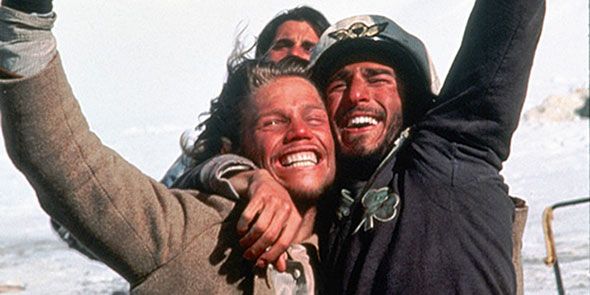Surviving in harsh environments such as deserts, mountains, oceans, or remote wilderness areas comes down to just a few critical factors…the first factor is knowledge – which is why we place so much importance on it on our wilderness survival courses Australia.
On SCT’s courses, we make sure that you are trained in the right mix of bushcraft and survival knowledge, as well as how to apply those key skills to face an emergency situation.
When determining who survives in any given emergency situation, the tools of survival lie in people’s brains, according to Dr K. Kramler.
“Knowledge is power, and, in this case, it is one of the keys to surviving. Consider it one of the cornerstones of surviving.”
The second factor that you need in order to survive an ordeal is conditioning. With a healthy body in good condition, plus the right survival knowledge and skill sets, you are much better placed to handle the stress induced by a survival situation.
The third factor you need in abundance is a willingness to survive. This might sound strange, but many people who face a survival situation simply give up – in a relatively short amount of time!
Willingness to survive is never, ever giving up. It’s the spirit to go on. It is an attitude and it’s certainly a mindset that you need to have.
In the face of all odds, it is the ability to keep going…always a little further! It is keeping on going. It’s one of the many aspects we teach on our wilderness survival courses in Australia.
This mindset is mentioned repeatedly in debriefs and interviews with POWs (prisoners of war) who have suffered torture and long-term confinement.
It is the brain that goes soft. It is the brain that gives up the fight for survival, as indicated by a documented scientific condition known as a ‘pschogenic death’ (more on this below).
A study by Laurence Gonzales notes that although there is some denial for survivors, they have acceptance of their reality. Denial is a defensive mechanism to protect the body from harm.
However, denial can lead to further harm.
If the victim’s leg is broken, they recognize that it is broken. If they are lost, they recognize that they are lost. Accepting their reality enables the victim to act.
When acting, survivors stay calm. Gonzales notes that survivors “think/analyse/plan.”
A really useful acronym to remember and have on your mind is STOP. It stands for:
- Sit
- Think
- Observe
- Plan
By sitting, the survivor stays calm. Thinking allows you to analyse the situation. Observing takes in the environment for what it is, and planning means planning a course of action.
The objective of planning is to create small tangible tasks that can be completed more easily.
“I will crawl fifty metres to that rocky outcrop.” “I will dig a snow cave for the night.” “I will splint my broken arm.”
 Completing small manageable tasks is a key point because it often leads to success, even if those tasks are really small. Break things down into bite-sized pieces.
Completing small manageable tasks is a key point because it often leads to success, even if those tasks are really small. Break things down into bite-sized pieces.
Survivors take corrective and decisive action. This is where proper survival and bushcraft knowledge is critical because it helps in making the correct decisions.
Although this may seem like a contradiction, studies show that survivors are both bold and cautious at the same time.
It is looking after the big picture by taking care of the small manageable tasks to keep you going and continue moving forward.
Remember also – that it may well not just be you who’s facing a survival situation. You may be part of a group and you might need to keep their spirits up, or inject some humour into the situation if they’re injured etc.
“It is the concept of applied knowledge that wins out in a survival situation.” (Sherwood)
In addition to survival knowledge and being trained in how to apply that knowledge in the real world, here are 8 ‘survival tools’ that you also need as part of a strong survival mindset.
Adaptability is the capacity to adjust quickly to different situations. It includes changing one’s attitude and behaviour to changing situations. He notes that adaptability is a critical survival tool.
Resilience is the ability of a material placed under stress to return to its original form. It is the elasticity of a material or its ability to change.
Sherwood notes that for people it is the ability to pick oneself up, dust yourself off, and persevere. Essentially, he equates resilience with perseverance.
Hope is a combination of optimism and realism. It is probably best to frame hope in terms of the belief in surviving while accepting the reality of the situation.
However, it’s advisable not to have too much optimism out in the field, as this can easily lead to disappointment and perseverance reduction.
Tenacity is the ability to persist with determination. It is an attribute of perseverance.
Love is a variation of purpose. People will do anything for the people they love. The bonds with family and friends are unbreakable.
When soldiers are asked who they fight for, often, their response is for the soldier next to them in their foxhole.
As a survival tool, Sherwood suggests that empathy may be counterintuitive. However, in a crisis the ability to feel a deep connection for others and to care for others not only helps the recipient but the giver to survive.
Ingenuity involves being clever, inventive and resourceful. It can be seen as a variation of adaptability or applied intelligence.
He notes that when water hits a rock in the river it flows over and around it. Like the river, he suggests that flow is the ability to move forward, effortlessly, steadily, relentlessly and with ease.
Wilderness Survival Courses Australia – Survival Psychology
Having hope is essential! A lack of hope that you’ll make it out is a massive downwards spiral.
Studies show that the effects of losing hope in a survival situation can literally kill you, which is a phenomenon that has been observed by shipwreck survivors, concentration camp victims, and early settlers.
POWs have described the deadly spiral that comes from a loss of hope as follows:
There are five stages that occur when a traumatic event creates psychogenic shock:
- This is characterised by social and behavioural withdrawal.
- Stage two is noticeable apathy.
- Stage three involves a loss of willpower, emotional responsiveness, and the ability to act concisely.
- Those in stage four stop responding to almost all external stimuli.
- Stage five is psychogenic death.
These symptoms are thought to occur as mental defense mechanisms to protect a person against the harsh and unfathomable odds that exist in survival situations.
However, as this leads to death, you must do everything in your power to avoid this reaction, regardless of how bad things seem.
Many incidents have happened where those facing a survival situation have been found dead just a hundred metres from a track, or from their own camp.
The terrain (e.g. jungle) or the conditions were bad enough that they couldn’t see that far ahead and had become so disorientated that they felt completely helpless and gave up.
I often think back to the survival story of the Uruguayan rugby team who were in flight over the Andes when their plane crashed into a high mountain peak.
It’s a true survival story, which you may know as the book or movie adaptation Alive.
The plane went down in October of 1972, and of the 45 people on the flight, only 16 survived in sub-zero temperatures.
 Rescuers spent numerous days searching for survivors in tough conditions, but the rescue team was forced to end the search.
Rescuers spent numerous days searching for survivors in tough conditions, but the rescue team was forced to end the search.
As such, the survivors had to stay alive with just the rations found in the wreckage after the plane went down. The rations did not last long though, and in order to survive they had to eat the bodies of their dead teammates.
The other passengers’ bodies had been preserved with the freezing temperatures and the snow.
If that wasn’t bad enough, they endured weeks up there in the mountains among deep winter snow before an avalanche ripped through what remained of their fuselage.
Finally, some weeks later, two of the surviving teammates decide that no help is coming and that they alone need to hike out of there to raise the alarm.
Amazingly, after a 12-day trek in harsh conditions and rugged terrain, the two friends escape the Andes mountains and were able to alert the authorities to their companions’ location who were then saved.
You can read more of our bushcraft and survival blogs here from SCT’s wilderness survival courses Australia.
